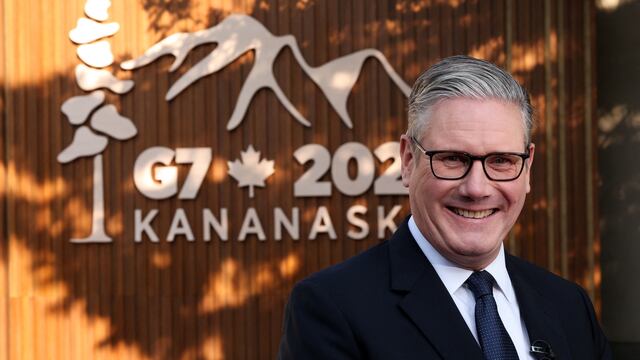With tensions growing in the Middle East amidst the conflict between Israel and Iran, leaders are convening to discuss how best to handle the situation.

What countries make up the G7? These are the seven nations meeting in Canada

This week, leaders representing the G-7, are meeting in Canada to discuss their continued partnership and alignment on how to continue confronting Russia in Ukraine and address the security risks of a larger conflict exploding in the Middle East as Israel continues its assault on the Gaza Strip and the Israeli conflict with Iran.
The G7 (Group of Seven Nations) consists of the U.S. along with France, Germany, Italy, Japan, Canada and the United Kingdom. It traces its origins to the early 1970s, emerging as a forum for addressing economic challenges in the wake of the collapse of the Bretton Woods system (see below). Originally comprising six members – France, Germany, Italy, Japan, the United Kingdom, and the United States – the group held its first summit in 1975, hosted by France.
Canada joined the following year, expanding the group to its current configuration of seven member states. Since then, the G7 has convened annually, with leaders engaging in discussions on a wide range of economic issues, including fiscal and monetary policy, trade liberalisation, and sustainable development.
From 1997 to 2014 Russia was also included in the group, which was referred to as the G8 during this time, but the nation was suspended indefinitely following the annexation of Crimea returning it to seven. The block of the European Union (EU) does now play a part in the G7, although doesn’t affect the name.
Despite standing as a beacon of economic prowess and diplomatic influence, for some the specifics of its composition remain shrouded in ambiguity.
Tension is high with Trump’s polices, tariffs and talk of Canada becoming the 51st state, which could undermine the group’s unity as disagreements arise over how to proceed in addressing the growing number of crises around the world.
The seven nations of the G7 and their leaders:
United States
As the world’s largest economy, the United States occupies a central position within the G7. With its vast industrial base, technological innovation, and formidable military prowess, it wields considerable influence over the group’s deliberations. Presidnet Joseph Biden has brought some stability back to the alliance after the tenure of Donald Trump and his ‘American First’ approach to international politics that isolated the country from most of its strongest historic allies.
Donald Trump and Joe Biden are expected to face off again for the US Presidency in November, though their position on their respective tickets will not be confirmed until this summer when the party’s host their conventions.
United Kingdom
A stalwart of the G7 since its inception, the United Kingdom brings to the table a rich tapestry of historical legacy and modern economic clout. Despite recent geopolitical upheavals, its global significance remains undiminished.
📍Rocky Mountains, Canada.
— UK Prime Minister (@10DowningStreet) June 16, 2025
Prime Minister @Keir_Starmer is here at the G7 to deliver for Britain. pic.twitter.com/iEtvYrKH8Q
Prime Minister Rishi Sunak has been leading the UK since 2022 and is facing an election in less than a month where his political party is expected to be wiped out by the Labor Party, led by Sir Kier Starmer. PM Sunak has come under fire recently for his decision to leave celebrations of the 80th anniversary of D-Day in Normandy to return to the UK for an interview. The celebrations were of great importance to all Allied governments as the 90th is unlike
Japan
Renowned for its technological prowess and industrial innovation, Japan commands a pivotal role within the G7. As a key player in the Asia-Pacific region, it provides a crucial bridge between East and West.
Germany
As the economic powerhouse of Europe, Germany stands as a paragon of industrial might and fiscal stability. Its voice carries weight within the G7, reflecting its status as an engine of European integration.
France
With its rich cultural heritage and diplomatic finesse, France lends an air of sophistication to the G7 proceedings. As a nuclear-armed nation and a permanent member of the United Nations Security Council, its geopolitical clout is undeniable.
Italy
Nestled at the crossroads of Europe, Italy infuses the G7 with its unique blend of historical legacy and Mediterranean charm. Despite economic challenges, it remains an integral member of the group, enriching discussions with its cultural perspective.
Canada
As a steadfast proponent of liberal democracy and multilateralism, Canada rounds off the G7 roster with its expansive geography and diverse society. Its commitment to progressive values and international cooperation amplifies the group’s collective voice on the world stage.
I’ve arrived in my home province of Alberta, ready to get to work with @G7 leaders.
— Mark Carney (@MarkJCarney) June 15, 2025
In an increasingly dangerous and divided world, we must build a new international system of integration — to deliver greater stability, prosperity, and security for all. pic.twitter.com/lMaBVZgxhT
European Union
Often referred to as its “8th member,” the EU enjoys all the benefits and responsibilities of membership but does not have the authority to host or lead a summit. Despite its significant involvement, the EU is not counted in the G7’s numerical designation as the group’s full title, the “Group of Seven Nations,” does not explicitly include the EU, resulting in eight members in total within the G7.
Tough for Trump to make deals with G7 countries when 61% to 81% in all have no confidence in Trump.
— (((Harry Enten))) (@ForecasterEnten) June 16, 2025
Median G7 country with no confidence in the U.S. president has jumped 22 pts from Biden to Trump.
A ridiculous 91% of Canadians want less reliance on U.S. as a trade partner. pic.twitter.com/qSo8639RXr
As the world grapples with unprecedented challenges ranging from climate change to global health crises, as well as growing conflicts across various parts of the globe, the importance of such collaborative endeavors cannot be overstated. And the stakes are high.
G7 leaders officially open their summit in Canada on Monday, with US President Donald Trump, German Chancellor Friedrich Merz and others meeting in Kananaskis.
— DW News (@dwnews) June 16, 2025
The Western powers are trying to unite amid escalating conflicts in the Middle East and Ukraine - and despite… pic.twitter.com/oLgSPhorQL
What was the Bretton Woods system?
Related stories
The Bretton Woods system was an international monetary framework established in 1944 to promote economic stability after World War II. Its key features included fixed exchange rates tied to the U.S. dollar, the creation of the International Monetary Fund (IMF) and the World Bank, and the gold convertibility of the dollar.
However, the system faced challenges and eventually collapsed in 1971 when the U.S. suspended the dollar’s convertibility into gold. Despite its end, Bretton Woods laid the foundation for international monetary cooperation and the establishment of key financial institutions.


Complete your personal details to comment